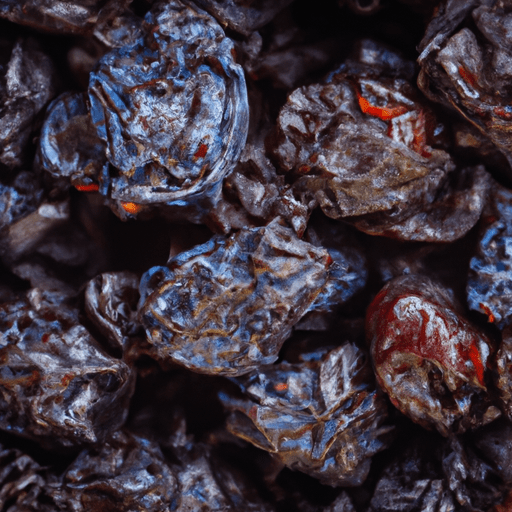Dried Blueberries: Bursting with Flavor, Health, and History
If you’re a fan of blueberries, you’re in for a real treat. Dried blueberries offer all the deliciousness you love about this vibrant fruit, preserved in a chewy and convenient form. In this blog post, we’ll explore the world of dried blueberries, from their mouth-watering taste to their nutritional benefits and intriguing history. So, grab a handful of these delightful little gems and let’s dive in!
The Taste: Sweet, Tart, and Intensely Blueberry
Dried blueberries are little pockets of flavor that burst in your mouth with a delightful combination of sweetness and tartness. They retain the essence of fresh blueberries, but with a more concentrated and chewy texture. Each bite offers a burst of intense blueberry taste, which is perfect for adding a pop of fruity goodness to a range of dishes.
Common Uses in Cooking: Versatile and Vibrant
Dried blueberries are a versatile ingredient that can elevate both sweet and savory dishes. Here are a few popular ways to use them in your culinary adventures:
Baking Brilliance:
Add dried blueberries to your favorite muffins, cookies, and scones for an extra burst of fruity goodness. They lend a delightful chewiness and bursts of flavor that perfectly complement the baked goods. You can also sprinkle them on top of cakes or tarts for a vibrant and visually appealing touch.
Breakfast Boost:
Enhance your morning routine by incorporating dried blueberries into your breakfast dishes. Sprinkle them over your cereal or oatmeal, mix them into pancake or waffle batter, or stir them into yogurt for a delightful and nutritious start to your day.
Savory Sensations:
Don’t limit dried blueberries to sweet treats; they can also shine in savory dishes. Add them to grain salads, such as quinoa or couscous, for an unexpected burst of sweetness. Toss them into a leafy green salad or mix them into a vinaigrette for a unique twist. They also work wonderfully in sauces and glazes for roasted meats or poultry.
Nutritional Value: A Bite-Sized Powerhouse
While dried blueberries are small, they pack a punch when it comes to their nutritional profile. Here are some highlights of their goodness:
- Fiber: Dried blueberries are an excellent source of fiber, aiding digestion and promoting a healthy gut.
- Antioxidants: Loaded with anthocyanins, a type of antioxidant, dried blueberries help fight inflammation and protect against oxidative stress.
- Vitamins and Minerals: Dried blueberries contain essential vitamins and minerals such as vitamin C, vitamin K, and manganese, all of which support overall health and well-being.
However, it’s important to note that dried blueberries are higher in sugar and calories compared to their fresh counterparts. So, moderation is key to enjoying their benefits without overindulging.
Fascinating History and Fun Facts
Blueberries have a rich history, with evidence of their consumption dating back thousands of years. Native to North America, blueberries were a staple food for indigenous people who used them both for nourishment and for medicinal purposes. Dried blueberries were among the various methods they used to preserve the fruit for long-term storage.
In more recent times, dried blueberries gained popularity in the late 19th and early 20th centuries due to their convenience and long shelf life. Since then, they have become a beloved ingredient in recipes spanning a wide range of culinary traditions.
Did you know that it takes about 8-10 pounds of fresh blueberries to yield just 1 pound of dried blueberries? That’s a testament to the concentrated flavors and nutrients found in each bite-sized piece.
Dried blueberries are a delightful ingredient that brings the essence of fresh blueberries to your kitchen all year round. Their enticing taste, versatility in cooking, and nutritional benefits make them a fantastic addition to a wide array of dishes. So, whether you’re baking up a storm or looking for a healthy snack, grab a bag of dried blueberries and savor the tangy, sweet goodness they have to offer!
Dried Blueberries
Origin: Blueberries are native to North America and have been consumed by indigenous peoples for centuries. They were first domesticated by Native Americans who used them as a food source, as well as for medicinal and dyeing purposes.
Common Uses: Dried blueberries are often used in baking, such as in muffins, breads, and cookies. They can also be added to breakfast cereals, trail mix, salads, or enjoyed as a snack on their own.
Nutritional Benefits: Blueberries, whether fresh or dried, are a good source of dietary fiber, vitamin C, and vitamin K. They are also rich in antioxidants, which help protect the body against oxidative stress. Dried blueberries are a convenient way to enjoy these nutritional benefits throughout the year.
Unique Properties: Dried blueberries have a longer shelf life than fresh blueberries and can be stored for extended periods. They have a concentrated flavor that is slightly sweeter than fresh blueberries. The drying process also makes them slightly chewy or leathery in texture.
Historical Significance: Native Americans used blueberries for various purposes. They made a type of “pemmican” by combining dried blueberries with meat and fat, which provided sustenance during long journeys. Blueberries were also used medicinally to treat ailments such as coughs and stomach problems.
Remember that dried blueberries may have added sweeteners or preservatives, depending on the brand or packaging. Always check the ingredient list and nutritional information before purchasing.




Use the share button below if you liked it.
It makes me smile, when I see it.